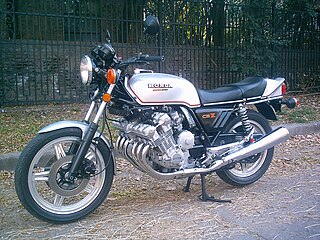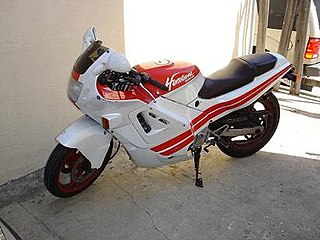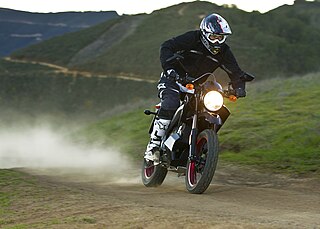
A motorcycle, often called a motorbike, bike, or cycle, is a two- or three-wheeled motor vehicle. Motorcycle design varies greatly to suit a range of different purposes: long-distance travel, commuting, cruising, sport, and off-road riding. Motorcycling is riding a motorcycle and being involved in other related social activity such as joining a motorcycle club and attending motorcycle rallies.

Indian Motorcycle is an American brand of motorcycles originally produced from 1901 to 1953 in Springfield, Massachusetts, United States. Hendee Manufacturing Company initially produced the motorcycles, but the name was changed to the Indian Motorcycle Manufacturing Company in 1923.

The Kawasaki Ninja ZX-12R is a motorcycle in the Ninja sport bike series made by Kawasaki from 2000 through 2006. The 1,199 cc (73.2 cu in) inline-four engine produced 178 hp (133 kW) at low speed, and increased to 190 hp (140 kW) at high speed due to its ram-air intake, making it the most powerful production motorcycle up to 2006 and the release of the ZX-14. It was a contender to be the fastest production motorcycle, and played a role in bringing to a truce the escalating competition to build an ever-faster motorcycle. Its top speed was electronically limited to 186 mph (300 km/h), tying it with the Suzuki Hayabusa and Kawasaki Ninja ZX-14 as the fastest production motorcycle on the market, after the 303–312 km/h (188–194 mph) 1999 Hayabusa was replaced with a speed-limited version as part of a gentlemen's agreement between motorcycle manufacturers that lasted until the 298–311 km/h (185.4–193.24 mph) 2007 MV Agusta F4 R 312.
The Honda ST series, also known as the Pan-European in Europe, is a duo of Sport Touring motorcycles comprising the ST1100 and the later ST1300.

The Suzuki GSX1300R Hayabusa is a sport bike motorcycle made by Suzuki since 1999. It immediately won acclaim as the world's fastest production motorcycle, with a top speed of 303 to 312 km/h.

The Honda CBX sports motorcycle was manufactured by Honda from 1978 to 1982. With a 1047cc inline six-cylinder engine producing 105 bhp (78 kW), it was the flagship of the Honda range. The CBX was well-received by the press, but was outsold by its sibling introduced in late 1979, the Honda CB900F.

There are many systems for classifying types of motorcycles, describing how the motorcycles are put to use, or the designer's intent, or some combination of the two. Six main categories are widely recognized: cruiser, sport, touring, standard, dual-purpose, and dirt bike. Sometimes sport touring motorcycles are recognized as a seventh category. Strong lines are sometimes drawn between motorcycles and their smaller cousins, mopeds, scooters, and underbones, but other classification schemes include these as types of motorcycles.

The Honda CBR1100XX Super Blackbird was a Honda motorcycle, part of the CBR series made from 1996 to 2007. The bike was developed to challenge the Kawasaki Ninja ZX-11 as the world's fastest production motorcycle, and Honda succeeded with a top speed of 178.5 mph (287.3 km/h). Two years later the title passed to the Suzuki Hayabusa, which reached 194 mph (312 km/h). The Blackbird is named after the Lockheed SR-71, also a speed record holder.

The ZZR1400 or Kawasaki Ninja ZX-14 and ZX-14R (2006–2020), is a motorcycle in the Ninja sport bike series from the Japanese manufacturer Kawasaki that was their most powerful sport bike as of 2006. It was introduced at the 2005 Tokyo Motor Show and released for the 2006 model year as a replacement for the Kawasaki ZZ-R1200 (2002-2005). The ZZR1400 is capable of accelerating from 0–60 mph in 2.5 seconds. The top speed is electronically limited to 186 mph (299 km/h) as a result of an agreement between the major Japanese and European motorcycle manufacturers.

The Honda CBR600F is a CBR series 600 cc (36.6 cu in) four-cylinder sport bike made by Honda. The first model of the CBR600F was sold from 1987 to 1990 and is known in the US as the Hurricane. In Austria and Mexico, a smaller version, called CBR500F, was offered. The subsequent models are designated as CBR600F2, F3, F4 and F4i respectively. In 2011, Honda released a more modern model with the same name.

The Triumph Trident and BSA Rocket 3 was a technically advanced, high-performance roadster motorcycle made by Triumph Engineering and BSA from 1968 to 1975, and sold under both the Triumph and BSA marques. Alongside the Honda CB750, and later the Kawasaki triples, it brought a new level of sophistication to street motorcycles, marking the beginning of the superbike era. The Honda CB750 overshadowed the Trident to be remembered as the 'first superbike', in spite of the Triumph Trident actually debuting before the Honda by a few weeks.

Electric motorcycles and scooters are plug-in electric vehicles with two or three wheels. The electricity is stored on board in a rechargeable battery, which drives one or more electric motors. Electric scooters have a step-through frame.

The Kawasaki Z1 is a four-cylinder, air-cooled, double-overhead camshaft, carbureted, chain-drive motorcycle introduced in 1972 by Kawasaki. Following the introduction of Honda's CB750 in 1968, the Z1 helped popularize the in-line, across-the-frame four-cylinder, a format that became known as the Universal Japanese Motorcycle or UJM.

The Kawasaki 1400GTR, also known as the Concours 14 or ZG1400 in some markets, is a sport touring motorcycle produced by Kawasaki. The 1400GTR was introduced in September 2007 and is based on the ZX-14 platform. It replaces the original GTR1000 (Concours), which was built from 1986 to 2006.

The Vincent Black Lightning was a Vincent-HRD motorcycle first built in September 1948 at the Vincent works in Great North Road, Stevenage, Hertfordshire, UK, and produced from 1948 to 1952. The bike was a purpose-built factory modified Black Shadow that was then named and produced as the Black Lightning. At the time the Black Lightning was the fastest production motorcycle in the world.
Forced induction in motorcycles is the application of forced induction to a motorcycle engine. Special automotive engineering and human factors considerations exist for the application of forced induction with motorcycles, compared to other forms of motorized transportation.

The Kawasaki Ninja H2 is a "supercharged supersport" class motorcycle in the Ninja sportbike series, manufactured by Kawasaki Heavy Industries, featuring a variable-speed centrifugal-type supercharger. The track-only variant is called Ninja H2R, and it is the fastest and most powerful production motorcycle on the market; it produces a maximum of 310 horsepower (230 kW) and 326 horsepower (243 kW) with ram air. The H2R has 50% more power than the fastest street-legal motorcycles, while the street-legal Ninja H2 has a lower power output of 200 hp (150 kW)–210 hp (160 kW) with ram air.

The Harley-Davidson KR or KR750 was a 45.125 cu in (739.47 cc) displacement V-twin engine racing motorcycle made by Harley-Davidson from 1953 through 1969 for flat track racing. It was also used in road racing in the KRTT faired version. When the KR was first introduced, it dominated motorcycle racing in the United States. In 1970 it was replaced by the long-lived and US race-winning Harley-Davidson XR-750.

The Energica Ego is an electrically propelled sport road motorcycle designed and marketed by Energica Motor Company. It is claimed by Energica to be the world's first street-legal electric Italian sport motorcycle. The prototype was finished in 2013 and the vehicle came into the market in 2015. The prototype made use of new technologies such as CNC and 3D-printing, including the dashboard and headlights which were 3D-printed.

















